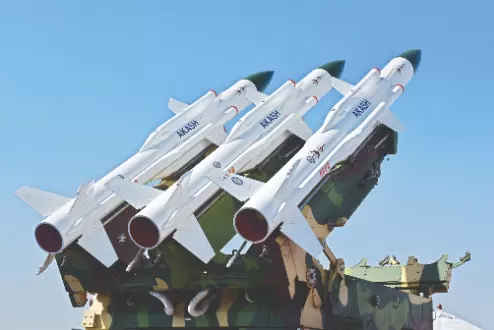India posts highest-ever defence output of Rs 1.54 lakh crore in FY25

New Delhi: The government on Thursday said that India recorded its highest-ever defence production of Rs 1.54 lakh crore in FY 2024–25, setting a new benchmark in the country’s pursuit of self-reliance in the defence sector. This growth is supported by the record indigenous production of Rs 1,27,434 crore in FY 24, a staggering 174 per cent increase from Rs 46,429 crore in FY15.
Similarly, once negligible defence exports have also seen an unprecedented rise. From under Rs 1,000 crore in 2014, India’s defence exports touched Rs 23,622 crore in FY25, reflecting a 12 per cent year-on-year growth. India is now supplying a wide range of military platforms, ammunition, sub-systems, and hardware to 80–100 countries, including technologically advanced nations such as the US and France, as well as strategic partners like Armenia.
The government attributed this surge to a “fully digital export authorisation framework, simplified licensing, and the rollout of Open General Export Licences.” Defence PSUs or DPSUs alone recorded a 42.85 per cent increase in export volumes in FY25 — a sign, officials said, of “growing global confidence in Indian defence capabilities.”
The Ministry of Defence, on its part, in an official communiqué, vaunted the self-reliance policy, stating that “the initiative has fundamentally reshaped the defence industrial landscape.” It further lauded the fact that India’s defence budget has almost tripled over the last decade — rising from Rs 2.53 lakh crore in FY14 to Rs 6.81 lakh crore in FY26 — demonstrating, according to the ministry, an “unambiguous commitment to strengthening military infrastructure through modernisation and local manufacturing.”
The government attributed this growth to the performance of both public and private sectors, more liberal foreign investment norms and an accelerated shift towards indigenisation. “The public sector entities, including DPSUs, continue to dominate, accounting for around 77 per cent of total output,” ministry officials said, adding that “the most notable transformation is the rising contribution of private players”, whose share increased from 21 per cent in FY24 to 23 per cent in FY25.
A network of close to 16,000 MSMEs is becoming a vital driver of innovation, providing drones, avionics, components, and advanced electronic systems. The government said that before 2014, India’s procurement processes were crippled by delays, restrictive policies, and heavy reliance on foreign suppliers, which resulted in capability gaps across the Armed Forces. It added that with defence exports standing at only Rs 686 crore in FY14, India was widely regarded as a major importer rather than a competitive manufacturer.
The government terms the launch of the Defence Production and Export Promotion Policy (DPEPP) as a big “game-changer.” Positive indigenisation lists, liberalised FDI norms — up to 74 per cent under the automatic route and 100 per cent through government approval — and a strong push toward R&D have collectively accelerated domestic capability-building. The rollout of a Rs 1 lakh crore Research, Development and Innovation (RDI) Scheme has further strengthened collaboration among DPSUs, private companies, MSMEs and start-ups.
A set of reforms at the institutional level, notably the Defence Acquisition Procedure (DAP) 2020 and the Defence Procurement Manual (DPM) 2025, has streamlined procurement processes while embedding transparency and faster decision-making. According to the ministry, DAP 2020 has been particularly transformational insofar as it accords topmost priority to the Buy (Indian–IDDM) category to ensure preference for systems that are indigenously designed, developed and manufactured. It has also opened up avenues for emerging technologies like AI, robotics, advanced sensors, cyber warfare systems and space-based assets.
DPM 2025, in turn, standardises and simplifies rules for revenue procurement, reduces liquidated damages for indigenisation projects, removes outdated No Objection Certificate requirements, and introduces digital tools for e-procurement and monitoring.
The momentum is evident in major acquisition approvals: government data shows that over the past two years, the Defence Acquisition Council has cleared record numbers of indigenous procurement proposals, ranging from medium-altitude long-endurance drones and torpedoes to missile systems, radars, naval guns, electronic warfare systems and autonomous underwater platforms.
In FY25 alone, the Ministry of Defence signed 193 contracts worth Rs 2,09,050 crore — the highest ever in any single financial year — with 177 of these awarded to domestic industry. India’s two Defence Industrial Corridors, one each in Uttar Pradesh and Tamil Nadu, have also emerged as powerful catalysts for growth. Together, they have attracted over Rs 9,145 crore in actual investments, backed by 289 MoUs promising over Rs 66,423 crore in potential opportunities.
These corridors are emerging as high-value manufacturing, testing, and industrial collaboration hubs. The ministry went on to highlight how the Defence Research and Development Organisation (DRDO) has grown beyond research to emerge as a “strategic enabler.” It now leads from the front on technology transfers, supports start-ups, and encourages linkages between industry and academia through 15 Defence Industry–Academia Centres of Excellence.
A dedicated Rs 500 crore Technology Development Fund is promoting deep-tech projects, while the restructuring of the Ordnance Factory Board into seven defence companies has allowed for greater autonomy and efficiency in production.
India’s growing defence exports are increasingly becoming instruments of strategic diplomacy. Training programmes, logistics partnerships, joint development efforts and supply of equipment now complement India’s defence relations with partner nations.
The widening export basket, including bulletproof jackets, surveillance systems, radars, lightweight torpedoes, Dornier aircraft and Chetak helicopters, underlines the breadth of domestic technological advancement.
Looking ahead, the government has set ambitious targets of Rs 3 lakh crore in defence manufacturing and Rs 50,000 crore in exports by 2029.



